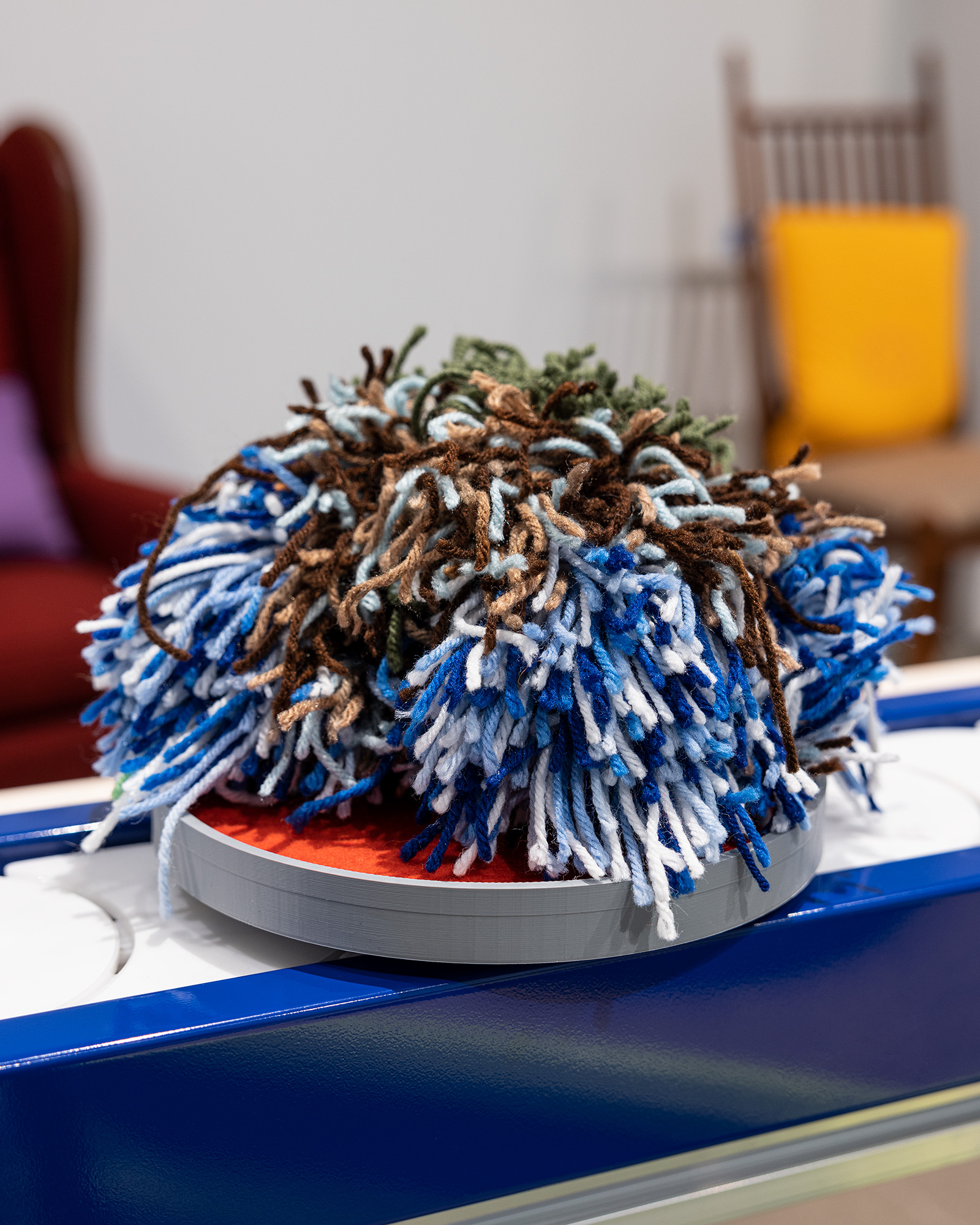

ABOVE: Don't mind if I do installation view at moCa Cleveland, 2023. All photos by Jacob Koestler.
Don’t mind if I do
Review
Christina Nafziger
I’m going to start this review in the same way the exhibition Don’t mind if I do begins: with delight, invitation, and blissful dreaming. Setting a tone is vital when navigating an exhibition (or review), and perhaps it is especially crucial when the topic explored is disability and accessibility. Walking into the exhibition space at the Museum of Contemporary Art Cleveland (masks required and provided at the door), I am quite literally greeted with the joyful words of Finnegan Shannon: “Welcome to my access fantasy!!” Shannon, a project-based artist who experiments with forms of access that intervene in ableist structures, co-organized the exhibition with the intention and dream of not only exhibiting alongside artists that “nourish my life and practice,” but also to create an environment that is comfortable, safe, and deliberately designed with those in mind who have specific accessibility needs.
What truly sets this exhibition apart is the way it is designed and how it functions. In the space, most of the artworks sit on a moving conveyor belt, not unlike a rotary sushi bar. Visitors are invited to sit on comfortable seating around the conveyor belt, which moves artworks around in an oval so that visitors need not move around the space physically to see each piece. They can simply sit, relax, get comfortable, and let the artworks come to them. For Shannon, who is disabled and needs to sit, this element of the exhibition was incredibly important in centering those who have similar needs. On the blue and white conveyor belt are works by Lukaza Branfman-Verissimo, Pelenakeke Brown, Sky Cubacub, Emilie L. Gossiaux, Felicia Griffin, Joselia Rebekah Hughes, Jeff Kasper, and Finnegan Shannon. The works by each artist are wildly different, but are all textural, three-dimensional, and inviting to the senses. By including this clever and fun structure, Finnegan “destabilizes rigid ableist and exclusionary museum ‘best practices’ like sparse seating, untouchable objects, dense wall labels, and guards who protect rather than invite engagement.”
Unlike most museum shows, visitors can touch and pick up the artworks, which conjured an entirely different experience than one might expect—myself included. I am a tactile person, and I loved having the opportunity to pick up, feel, and inspect works like Sky Cubacub’s piece Violet, Purple, and Gunmetal Chainmaille Packer, a hard, intricate metal sculpture satisfying to touch, or Felicia Griffin’s Pom-Pom, a soft, textural fabric-based piece that begged to be held like a stuffed animal. There were several pieces that connected to the lived experiences of the artists, such as Verbena's Apothecary by Joselia Rebekah Hughes, which consisted of different-colored pill bottles with phrases such as, “READ IF IT HURTS DEEP DOWN, BEYOND MEASURE.” Other objects in the room nodded at experiences of those with disabilities and who are and have been especially at risk during the COVID pandemic. In corners around the gallery space are DIY air purifiers, bright and colorful with neon yellows and vivid blues, which at first look like a fun cardboard craft before realizing what the reality would be for those at risk if they did not have access to this purifier. The aesthetics as a whole are bright and playful, but with a gravity of reality that those with specific needs don’t have the luxury of ignoring.
When sitting down and witnessing each artwork moving around the room in front of me, something unexpected happened. I began to feel anxiety from the artworks moving faster than I would prefer. I took a piece off the conveyor belt, but then I wasn’t sure how to navigate putting it back. It took me a minute to assess the space, process how the conveyor belt was functioning, and construct a plan of how I would approach engaging with each object and the exhibition as a whole. What I realized in that moment is: this experience may be noteworthy to me, but it is certainly not to others. The mental labor that is required when assessing a space (and whether or not you will be able to find safety, comfort, and accessibility within it) is something that those with disabilities do everyday without end. It is not an uncommon experience—our culture just does not give it priority. I am an able-bodied person and, unfortunately, most exhibition spaces are designed for this type of body in mind.
In Don’t mind if I do, perhaps I wasn’t the assumed visitor this time. I am aware that I am in a position of privilege every time I enter an exhibition that requires any stairs, but this exhibition revealed much, much more. These different points of access, the multiple ways of engaging with the space and work, and the physical function of the design of the show intentionally required a change in how I process space and my awareness of other bodies within that space. This beautiful shift that the exhibition opened up should not just be a learning opportunity for myself, but also for others building exhibitions. Curators, museum educators, and other museum workers that have a say in the design of their institution’s exhibitions could learn a lot from Finnegan’s design, which addresses and recognizes multiple types of accessibility needs. Although there are certainly museum workers in the field working hard to create accessible exhibitions, the overwhelming majority of institutions do not address the accessibility needs of the Disabled community, or just meet the bare minimum required by the Americans with Disabilities Act. For example, think back to the last time you went to an art museum—how many benches did you see? How many stairs with handrails and/or elevators? How large were the fonts of the wall labels and how many included braille?
The beauty and brilliance of this exhibition lies not only within the artworks themselves, but in the navigating and understanding of the function of the space. Imagine the possibilities and creative potential if accessibility was centered in more spaces. What would it look like for all exhibitions to be designed with accessibility in mind? How would and could visitors interact and engage with art in a gallery or museum setting if folks with disabilities were centered and/or involved in creating the exhibition? Don’t mind if I do demonstrates that the possibilities could be endless.
-
Don’t mind if I do is on view at the Museum of Contemporary Art Cleveland through January 7, 2024.

Don't mind if I do installation view at moCa Cleveland, 2023.

Sky Cubacub, Violet, Purple, and Gunmetal Chainmaille Packer, 2023. Chainmaille, Full Persian weave-anodized aluminum jump rings. Courtesy of Rebirth Garments.

Felicia Griffin, Pom-Pom, 2020. Yarn. Courtesy of the artist and NIAD Art Center.
 Finnegan Shannon, House that I modified to be stair-free and planted lavender in the garden for us, 2023. Modified vintage tissue box cover kit.
Finnegan Shannon, House that I modified to be stair-free and planted lavender in the garden for us, 2023. Modified vintage tissue box cover kit.
Don't mind if I do installation view at moCa Cleveland, 2023.
-
12.21.23
Christina Nafziger (she/her) is a Chicago-based arts writer and editor who is interested in artists with research-based practices, the effect archiving has on memory and identity, and the ways in which archiving can alter and edit future histories.
12.21.23
Christina Nafziger (she/her) is a Chicago-based arts writer and editor who is interested in artists with research-based practices, the effect archiving has on memory and identity, and the ways in which archiving can alter and edit future histories.







